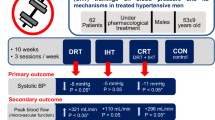Abstract
This report examines the relationship between blood pressure and cortisol in normotensives and hypertensives. Both groups received biofeedback-assisted relaxation training. Both groups significantly decreased their muscle tension levels from baseline. Only the hypertensives decreased their blood pressure and cortisol levels after training. Implications for the role of cortisol in the relaxation response and in hypertension are discussed.
Similar content being viewed by others
References
Cugini, P., Piernatale, L., Tomassini, R., Centanni, M., Salandi, E., and Scavo, D. (1972). Circadian rhythms of plasma renin, aldosterone and cortisol. Effect of beta-adrenergic blockade by propranolol in patients with recent, advanced and complicated forms of essential hypertension.Chronobiologia 9: 229.
Everitt, A. V. (1980). The neuroendocrine system and aging.Gerontology 26: 108–119.
Guyton, A. (1981).Textbook of Medical Physiology, Philadelphia, W. B. Saunders.
Hausler, A., Girard, J., Baumann, J. B., Ruch, W., and Otten, U. H. (1983). Stress-induced secretion of ACTH and corticosterone during development of spontaneous hypertension in rats.Clin. Exp. Hyper-Theory Pracl. A5(1): 11–19.
Ignatowska-Switalska, H., Wocial, B., Skorka, B., Chodakowska, J., Nazar, K., and Chwalbinska-Moneta, J. (1980). Plasma renin activity, aldosterone and cortisol levels during physical exercise in essential hypertension.Acta Physiol. 31: 631–635.
Jevning, R., Wilson, A. F., and Davidson, J. M. (1978). Andrenocortical activity during meditation.Hormones Behav. 10: 54–60.
Laragh, J. H., and Sealey, J. E. (1982). Endocrine control of the vasoconstriction and volume determinants of blood pressure by the renin-aldosterone systems: Its relevance for analysis of hypertension disorders. In Mantero, F., Biglieri, E. G., and Edwards, C. R. W., (eds.),Endocrinology of Hypertension, Academic Press, London and New York, pp. 223–242.
Lohmeier, T. E., and Kastner, P. R. (1982). Chronic effects of ACTH and cortisol excess on arterial pressure in normotensive and hypertensive dogs.Hypertension 4: 652–661.
Luthe, W. (1969).Autogenic Therapy, Grune and Stratton, New York.
McGrady, A. V., Yonker, R., Tan, S. Y., Fine, T., and Woerner, M. (1981). The effect of biofeedback-assisted relaxation training on blood pressure and selected biochemical parameters in patients with essential hypertension.Biofeed Self-Regul. 5: 25–44.
Munck, A., Guyre, P. M., and Holbrook, N. J. (1984). Physiological functions of glucocorticoids in stress and their relation to pharmacological actions.Endocrine Rev. 5: 25–44.
Scoggins, B. A., Coghlan, J. P., Wenton, D. A., Mason, R. T., and Whitworth, J. A. (1982). A review of mechanisms involved in the production of steroid induced hypertension with particular reference to ACTH dependent hypertension. In Mantero, F., Biglieri, E. G., and Edwards, C. R. W. (eds.),Endocrinology of Hypertension, Academic Press, New York, Vol. 50.
Seyle, H. (1974).Stress Without Distress, Signet, New York.
Shapiro, A. P., Benson, H., Chobanian, A. V., Herd, J. A., Julius, S., Kaplan, N., Lazarus, R. S., Ostfeld, A. M., and Syme, L. (1979). The role of stress in hypertension.J. Hum. Stress 5: 7–27.
Stephenson, R. B. (1984). Modification of reflex regulation of blood pressure by behavior.Annu. Rev. Physiol. 46: 133–142.
Ulrick, S., Levine, L. S., Bunczler, P., Zanconato, G., Ramierez, L. C., Rauh, W., Rosler, A., Bradlow, H. L., and New, M. I. (1979). A syndrome of apparent mineralocorticoid excess associated with defects in the peripheral metabolism of cortisol.J. Clin. Endocrinol. Metab. 49: 757–764.
Vermuelen, A., and Van Der Straeten, M. (1963). Adrenal cortical function in benign essential hypertension.J. Clin. Endocrinol Metab. 23: 574–578.
Weitzman, E. D., Fukushima, D., Nageire, C., Roffward, H., Gallagher, T. F., and Hellman, L. (1971). Twenty-four hour pattern of the episodic secretion of cortisol in normal subjects.J. Clin. Endocrinol. Metab. 33: 14–22.
Author information
Authors and Affiliations
Rights and permissions
About this article
Cite this article
McGrady, A., Woerner, M., Argueta Bernal, G.A. et al. Effect of biofeedback-assisted relaxation on blood pressure and cortisol levels in normotensives and hypertensives. J Behav Med 10, 301–310 (1987). https://doi.org/10.1007/BF00846543
Accepted:
Issue Date:
DOI: https://doi.org/10.1007/BF00846543




